Pellet as a Technological Nutrient within the Circular Economy Model: Comparative Analysis of Combustion Efficiency and CO and NOx Emissions for Pellets from Olive and Almond Trees
Abstract
:1. Introduction
2. Results and Discussion
2.1. Physicochemical Analysis
2.2. CO and NOx Emissions
2.3. Combustion Efficiency
3. Materials and Methods
3.1. Physicochemical Characterization of Fuels
3.2. Description of BIO System Equipment
3.3. Experimental Procedure
- Initial fuel filling and turning-on of the BIO System burner by means of a hot-air igniter oriented towards the fuel pile (Figure 9). During this first stage, primary and secondary air fans are switched on, so there is a high excess of air in the chamber.
- The BIO System burner is fed with new particles of biomass. The operating times for the screw feeder are 3 s in ON position and 20 s in OFF position. During this stage, there is a gradual increase of CO in flue gases, which corresponds to a slow progressive rise in the flow of the biomass introduced into the chamber until the mass flow necessary to obtain the nominal power of the experimental system (165 kW) is reached. In the case of the BIO System burner, the mass flow is within the range of 35 kg·h−1 and 40 kg·h−1. There is a soft start-up of the system in this way.
- Combustion stabilization with screw feeder times of 3/20 s. A stable situation is reached after several minutes when the combustion is maintained with only the heat contribution of the biomass (there is no need to use the hot-air igniter). In this regard, the total air flow needed is a key parameter to ensure the correct operation of the system and a stable combustion process. In this case, total air flow presents a value ranging between 290 m3·h−1 and 300 m3·h−1, with an excess of air fluctuating between 60% and 80%.
- Rise in fuel load. When the combustion process and resulting power are in steady conditions, such conditions are kept for as long as data collection lasts in order to compare the emissions obtained for each of the partial loads until they reach nominal power.
- Turning-off of the BIO System burner. The biomass feeding system is switched off whereas primary and secondary air fans are on, so that any remaining material that may remain in the burner is consumed.
3.4. Analysis of CO and NOx Emissions
3.5. Combustion Efficiency
- Non-burnt solid losses, Qn−b,s, have not been quantified, as the operating time under stable conditions was not long enough to obtain a representative value for each power range studied. Consequently, no non-burnt solid losses have been assumed.
- As the ash content of the fuel was lower than 3% (Table 2), the value of Qsa, which refers to sensitive heat losses in ash, has not been considered, since those losses are considered to be practically insignificant.
- For this calculation, the following constants were used: 11.8421 m3·h−1 for water volumetric flow and 4.185 kJ·kg−1·°C−1 for water specific heat.
4. Conclusions
Acknowledgments
Author Contributions
Conflicts of Interest
References
- González, J.F.; González-García, C.M.; Ramiro, A.; Gañán, J.; Ayuso, A.; Turegano, J. Use of energy crops for domestic heating with a mural boiler. Fuel Process. Technol. 2006, 87, 717–726. [Google Scholar] [CrossRef]
- Luque, R.; Davila, H.H.; Campelo, J.M.; Clark, J.H.; Hidalgo, J.M.; Luna, D.; Marinas, J.M.; Romero, A.A. Biofuels: A technological perspective. Energy Environ. Sci. 2008, 1, 542–564. [Google Scholar] [CrossRef]
- Zuwała, J. Life cycle approach for energy and environmental analysis of biomass and coal co-firing in CHP plant with backpressure turbine. J. Clean. Prod. 2012, 35, 164–175. [Google Scholar] [CrossRef]
- Lieder, M.; Rashid, A. Towards circular economy implementation: A comprehensive review in context of manufacturing industry. J. Clean. Prod. 2016, 115, 36–51. [Google Scholar] [CrossRef]
- Jorquera, O.; Kiperstok, A.; Sales, E.A.; Embiruçu, M.; Ghirardi, M.L. Comparative energy life-cycle analyses of microalgal biomass production in open ponds and photobioreactors. Bioresour. Technol. 2010, 101, 1406–1413. [Google Scholar] [CrossRef] [PubMed]
- Muthuraman, M.; Namioka, T.; Yoshikawa, K. A comparison of co-combustion characteristics of coal with wood and hydrothermally treated municipal solid waste. Bioresour. Technol. 2010, 101, 2477–2482. [Google Scholar] [CrossRef] [PubMed]
- García, R.; Pizarro, C.; Lavín, A.G.; Bueno, J.L. Characterization of Spanish biomass wastes for energy use. Bioresour. Technol. 2012, 103, 249–258. [Google Scholar] [CrossRef] [PubMed]
- Dare, P.; Gifford, J.; Hooper, R.J.; Clemens, A.H.; Damiano, L.F.; Gong, D.; Matheson, T.W. Combustion performance of biomass residue and purpose grown species. Biomass Bioenergy 2001, 21, 277–287. [Google Scholar] [CrossRef]
- Friberg, R.; Blasiak, W. Measurements of mass flux and stoichiometry of conversion gas from three different wood fuels as function of volume flux of primary air in packed-bed combustion. Biomass Bioenergy 2002, 23, 189–208. [Google Scholar] [CrossRef]
- McKendry, P. Energy production from biomass (part 1): Overview of biomass. Bioresour. Technol. 2002, 83, 37–46. [Google Scholar] [CrossRef]
- Kylili, A.; Christoforou, E.; Fokaides, P.A. Environmental evaluation of biomass pelleting using life cycle assessment. Biomass Bioenergy 2016, 84, 107–117. [Google Scholar] [CrossRef]
- Shen, D.K.; Gu, S.; Luo, K.H.; Bridgewater, A.V.; Fang, M.X. Kinetic study on thermal decomposition of woods in oxidative environment. Fuel 2009, 88, 1024–1030. [Google Scholar] [CrossRef]
- Permchart, W.; Kouprianov, V.I. Emission performance and combustion efficiency of a conical fluidized-bed combustor firing various biomass fuels. Bioresour. Technol. 2004, 92, 83–91. [Google Scholar] [CrossRef] [PubMed]
- Hall, D.O.; Rosillo-Calle, F.; de Groot, P. Biomass energy lessons from case studies in developing countries. Energy Policy 1992, 20, 62–73. [Google Scholar] [CrossRef]
- Demirbas, A. Combustion characteristics of different biomass fuels. Prog. Energy Combust. Sci. 2004, 30, 219–230. [Google Scholar] [CrossRef]
- Fernández, R.G.; García, C.P.; Lavín, A.G.; de las Heras, J.L. Study of main combustion characteristics for biomass fuels used in boilers. Fuel Process. Technol. 2012, 103, 16–26. [Google Scholar] [CrossRef]
- Barbanera, M.; Lascaro, E.; Stanzione, V.; Esposito, A.; Altieri, R.; Bufacchi, M. Characterization of pellets from mixing olive pomace and olive tree pruning. Renew. Energy 2016, 88, 185–191. [Google Scholar] [CrossRef]
- Calderon, C.; Jossart, J.M. European Bioenergy Outlook 2013; European Biomass Association (AEBIOM): Brussels, Belgium, December 2013. [Google Scholar]
- Sesli, M.; Yegenoglu, E.D. RAPD-PCR analysis of cultured type olives in Turkey. Afr. J. Biotechnol. 2009, 8, 3418–3423. [Google Scholar]
- Aktas, T.; Thy, P.; Williams, R.B.; McCaffrey, Z.; Khatami, R.; Jenkins, B.M. Characterization of almond processing residues from the Central Valley of California for thermal conversion. Fuel Process. Technol. 2015, 140, 132–147. [Google Scholar] [CrossRef]
- Chen, P.; Cheng, Y.; Deng, S.; Lin, X.; Huang, G.; Ruan, R. Utilization of almond residues. Int. J. Agric. Biol. Eng. 2010, 3, 1–18. [Google Scholar]
- González, J.F.; González-García, C.M.; Ramiro, A.; Gañán, J.; González, J.; Sabio, E.; Román, S.; Turegano, J. Use of almond residues for domestic heating. Study of the combustion parameters in a mural boiler. Fuel Process. Technol. 2005, 86, 1351–1368. [Google Scholar] [CrossRef]
- Nogués, F.S.; García, D.; Rezeau, A. Energías Renovables-Energía de la Biomasa (Volumen I); Prensas Universitarias de Zaragoza: Zaragoza, Spain, 2010; pp. 1–557. [Google Scholar]
- Küçük, M.M.; Demirbas, A. Biomass conversion processes. Energy Convers. Manag. 1997, 38, 151–165. [Google Scholar] [CrossRef]
- Van Loo, S.; Koppejan, J. The Handbook of Biomass Combustion and Co-Firing; Earthscan: London, UK, 2010; pp. 1–442. [Google Scholar]
- González, J.F.; González-García, C.M.; Ramiro, A.; González, J.; Sabio, E.; Gañán, J.; Rodríguez, M.A. Combustion optimisation of biomass residue pellets for domestic heating with a mural boiler. Biomass Bioenergy 2004, 27, 145–154. [Google Scholar] [CrossRef]
- Tissari, J.; Hytonen, K.; Sippula, O.; Jokiniemi, J. The effects of operating conditions on emissions from masonry heaters and sauna stoves. Biomass Bioenergy 2009, 33, 513–520. [Google Scholar] [CrossRef]
- Lehtikangas, P. Quality properties of pelletised sawdust, logging residues and bark. Biomass Bioenergy 2001, 20, 351–360. [Google Scholar] [CrossRef]
- Gilbert, P.; Ryu, C.; Sharifi, V.; Swithenbank, J. Effect of process parameters on pelletisation of herbaceous crops. Fuel 2009, 88, 1491–1497. [Google Scholar] [CrossRef]
- Kaliyan, N.; Vance, R. Factors affecting strength and durability of densified biomass products: Review. Biomass Bioenergy 2009, 33, 337–359. [Google Scholar] [CrossRef]
- Oravainen, H. Testing Methods and Emission Requirements for Small Boilers (<300 kW) in Europe; VTT Energy: Helsinki, Finland, 2000; pp. 1–13. [Google Scholar]
- ISO 17829:2015. Solid Biofuels. Determination of Length and Diameter of Pellets; International Organization for Standardization (ISO): Geneva, Switzerland, 2015. [Google Scholar]
- EN 15150:2011. Solid Biofuels. Determination of Bulk Density; European Norm (EN): Brussels, Belgium, 2011. [Google Scholar]
- ISO 18134-2:2015. Solid Biofuels. Determination of Moisture Content. Oven Dry Method. Part 2: Total Moisture. Simplified Method; International Organization for Standardization (ISO): Geneva, Switzerland, 2015. [Google Scholar]
- ISO 18122:2015. Solid Biofuels. Determination of Ash Content; International Organization for Standardization (ISO): Geneva, Switzerland, 2015. [Google Scholar]
- ISO 18123:2015. Solid Biofuels. Determination of the Content of Volatile Matter; International Organization for Standardization (ISO): Geneva, Switzerland, 2015. [Google Scholar]
- ISO 16948:2015. Solid Biofuels. Determination of Total Content of Carbon, Hydrogen and Nitrogen; International Organization for Standardization (ISO): Geneva, Switzerland, 2015. [Google Scholar]
- ISO 16994:2015. Solid Biofuels. Determination of Total Content of Sulfur and Chlorine; International Organization for Standardization (ISO): Geneva, Switzerland, 2015. [Google Scholar]
- EN 14918:2009. Solid Biofuels. Determination of Calorific Value; European Norm (EN): Brussels, Belgium, 2009. [Google Scholar]
- Verma, V.K.; Bram, S.; Delattin, F.; Laha, P.; Vandendael, I.; Hubin, A.; de Ruyck, J. Agro-pellets for domestic heating boilers: Standard laboratory and real life performance. Appl. Energy 2012, 90, 17–23. [Google Scholar] [CrossRef]
- Dias, J.; Costa, M.; Azevedo, J.L.T. Test of a small domestic boiler using different pellets. Biomass Bioenergy 2004, 27, 531–539. [Google Scholar] [CrossRef]
- Verma, V.K.; Bram, S.; Gauthier, G.; de Ruyck, J. Evaluation of the performance of a multi-fuel domestic boiler with respect to the existing European standard and quality labels: Part-1. Biomass Bioenergy 2011, 35, 80–89. [Google Scholar] [CrossRef]
- Verma, V.K.; Bram, S.; Gauthier, G.; de Ruyck, J. Performance of a domestic pellet boiler as a function of operational loads: Part-2. Biomass Bioenergy 2011, 35, 272–279. [Google Scholar] [CrossRef]
- Persson, T.; Fiedler, F.; Nordlander, S.; Bales, C.; Paavilainen, J. Validation of a dynamic model for wood pellet boilers and stoves. Appl. Energy 2009, 86, 645–656. [Google Scholar] [CrossRef]
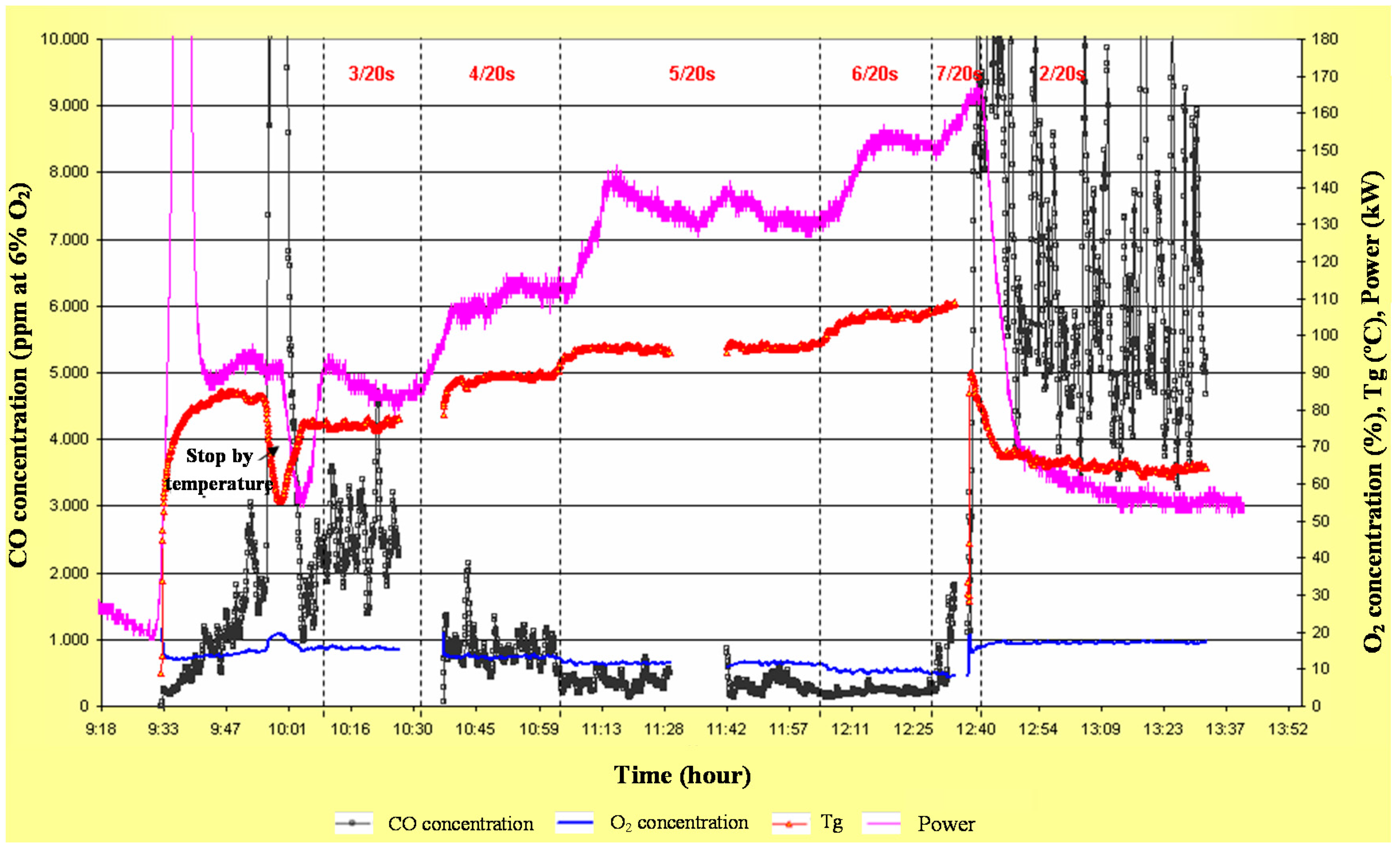


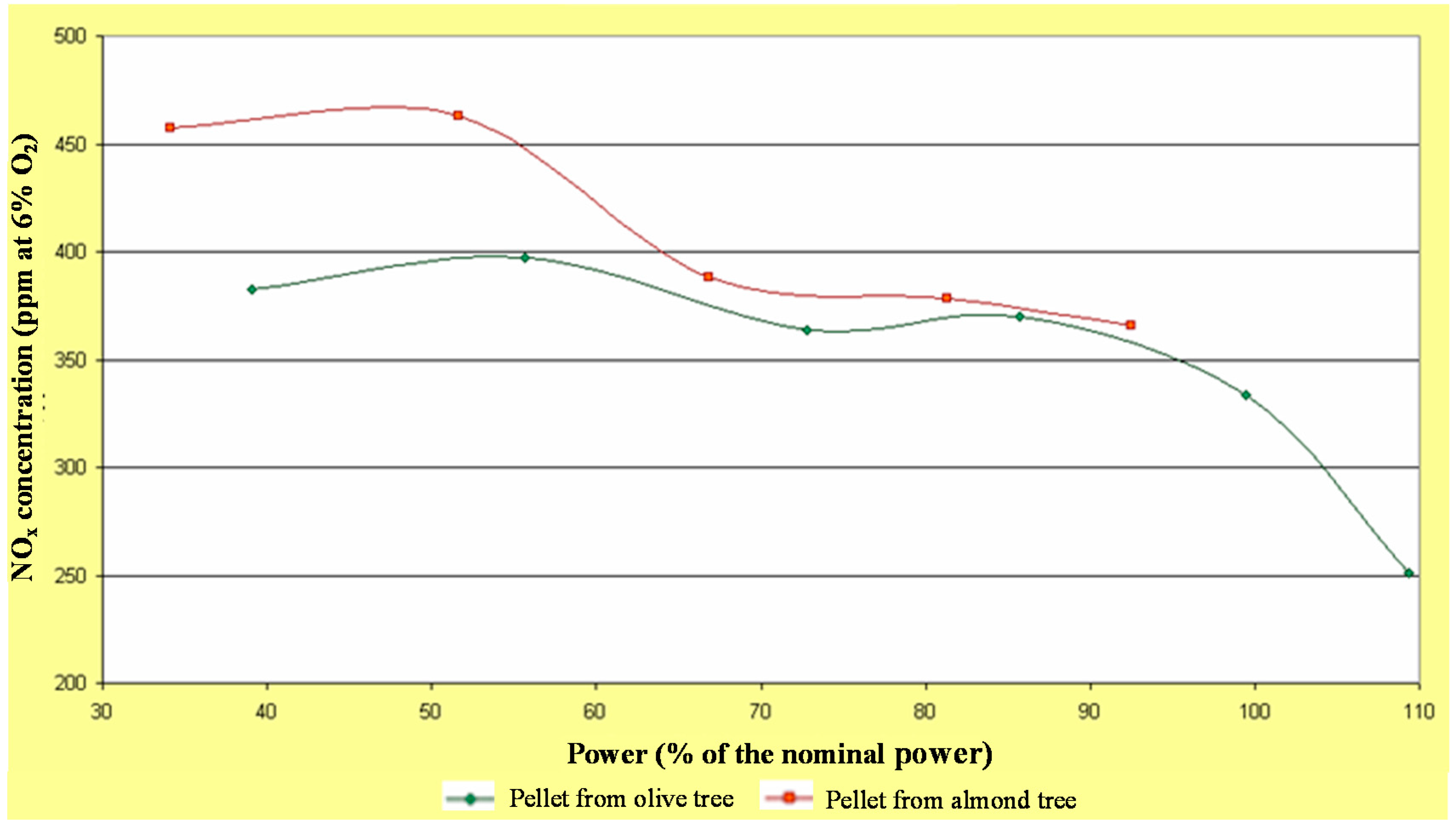
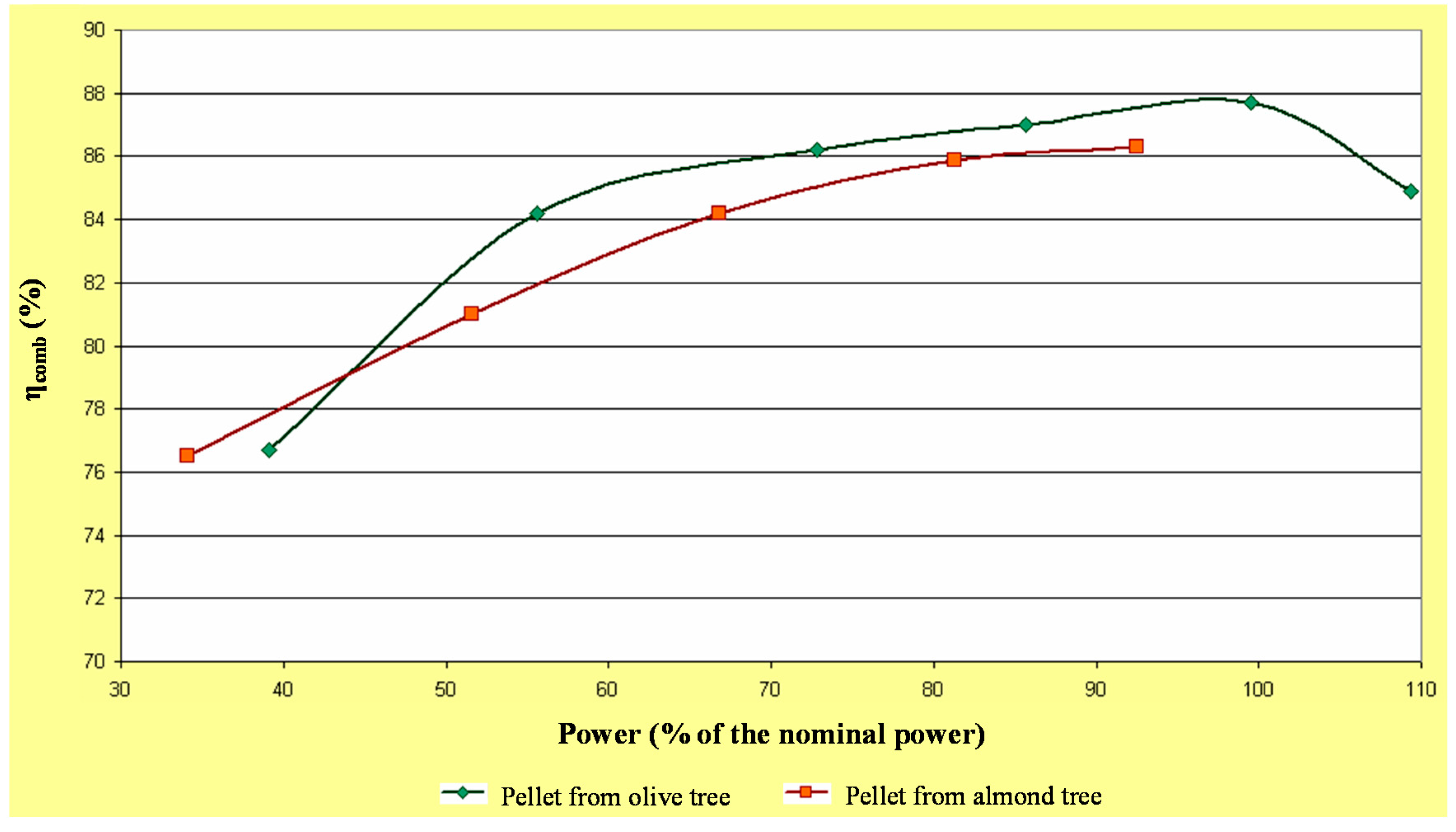
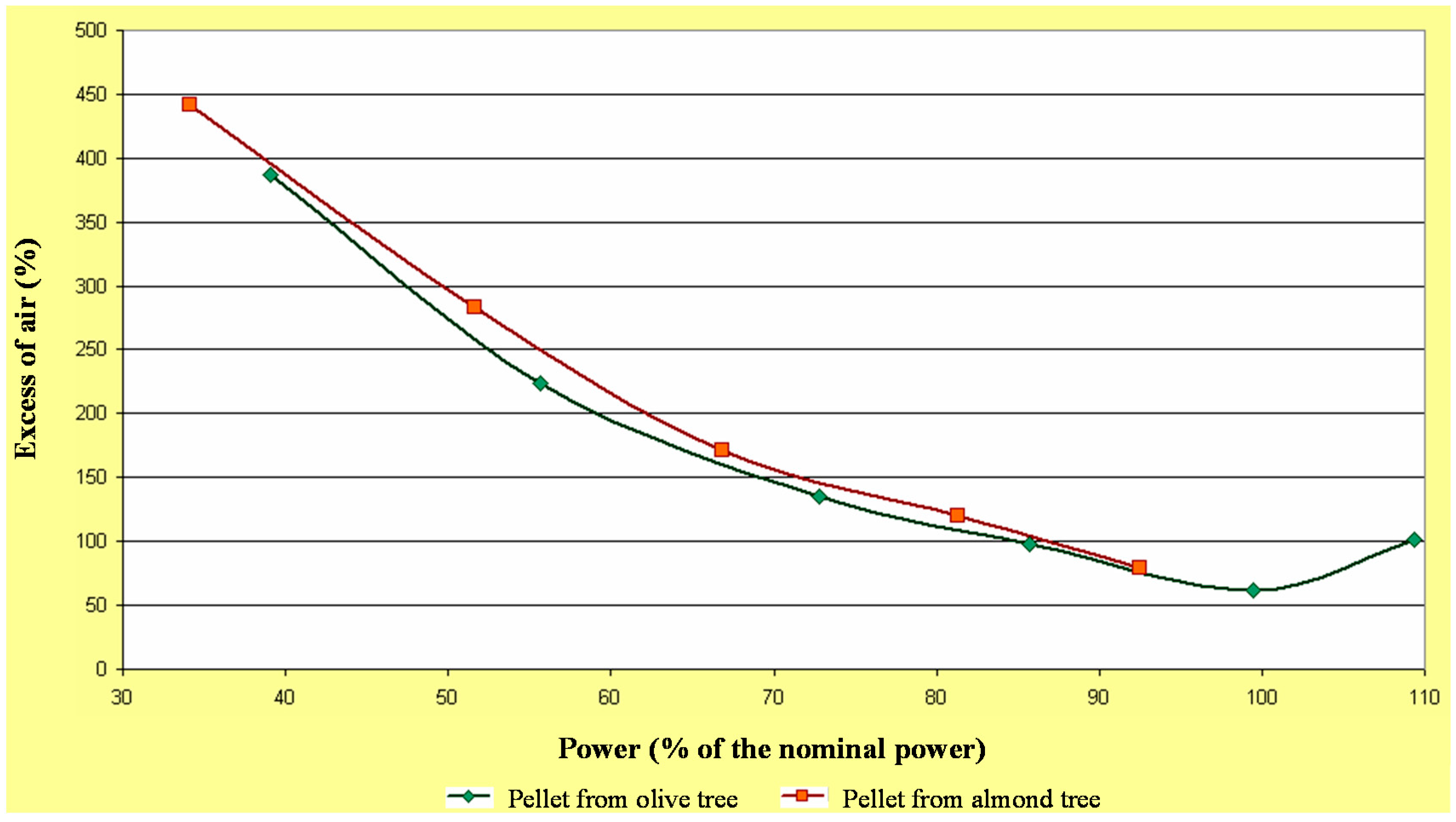
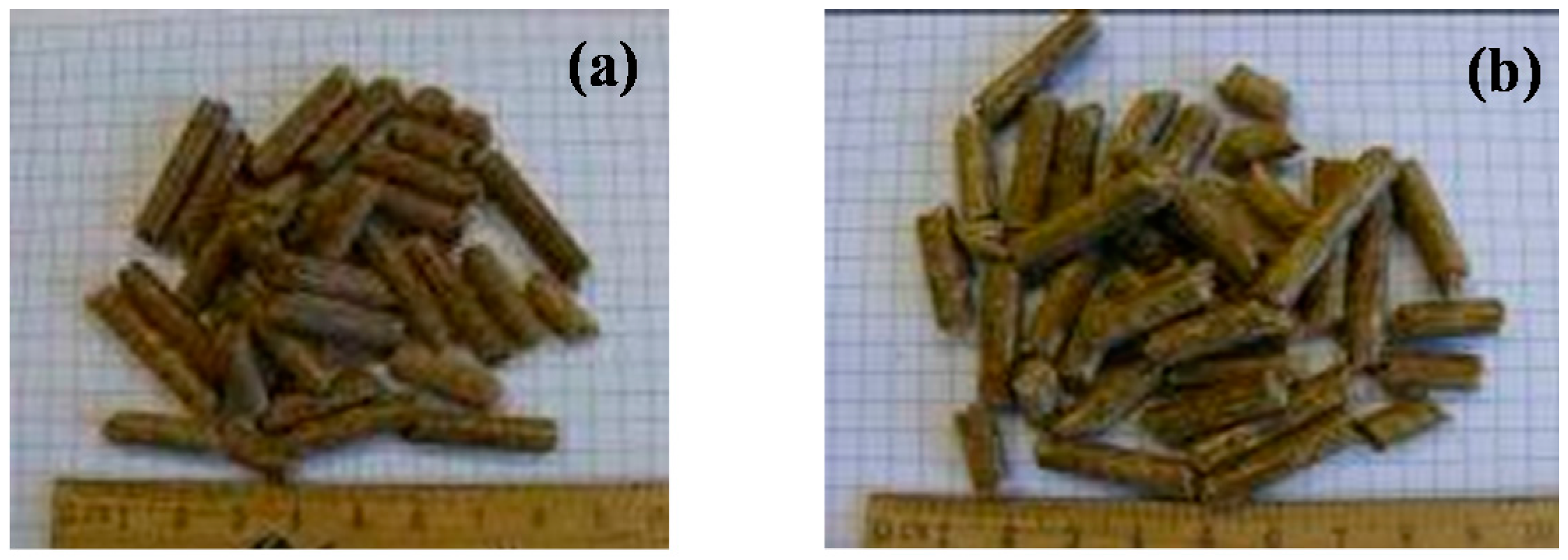
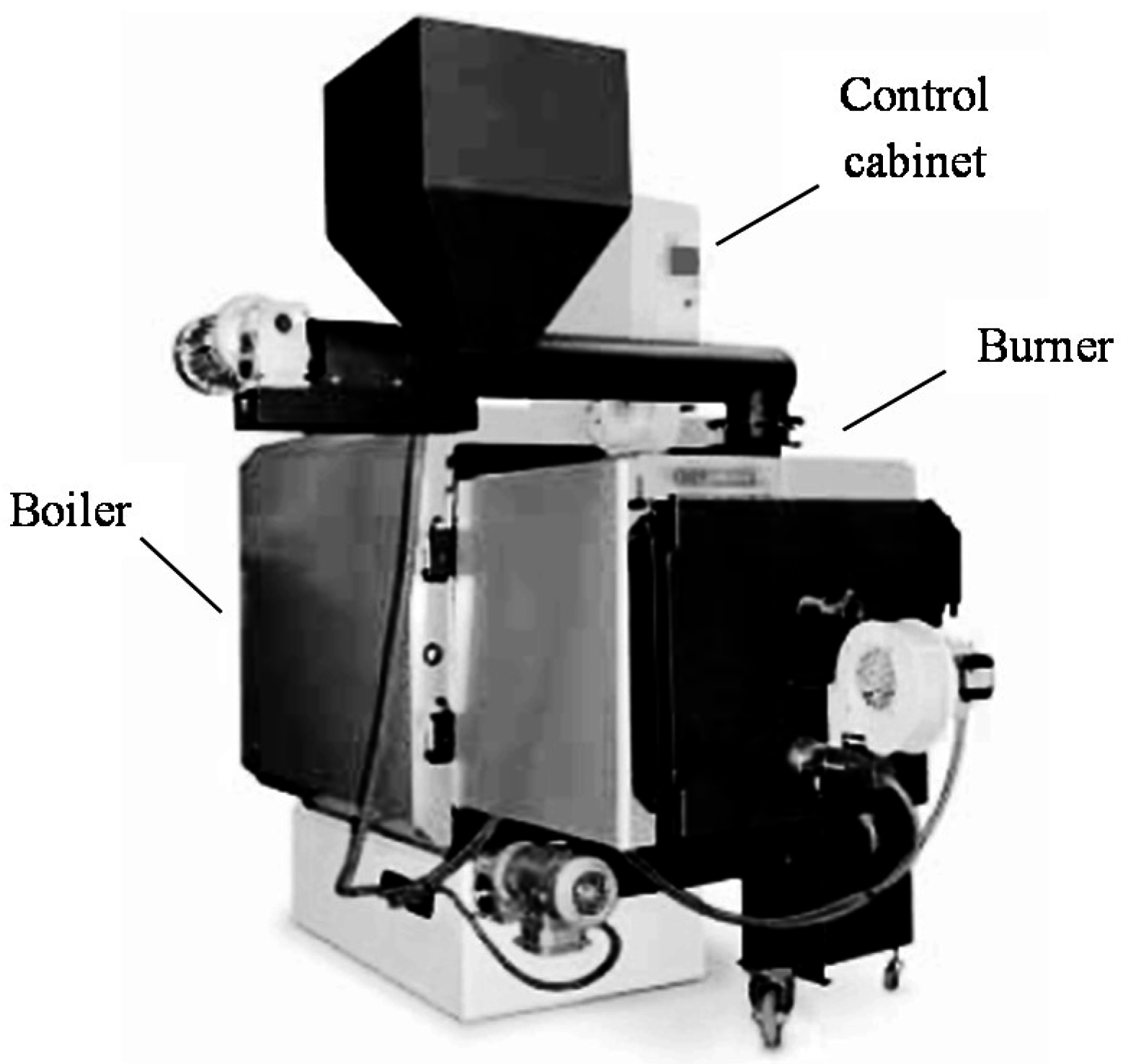
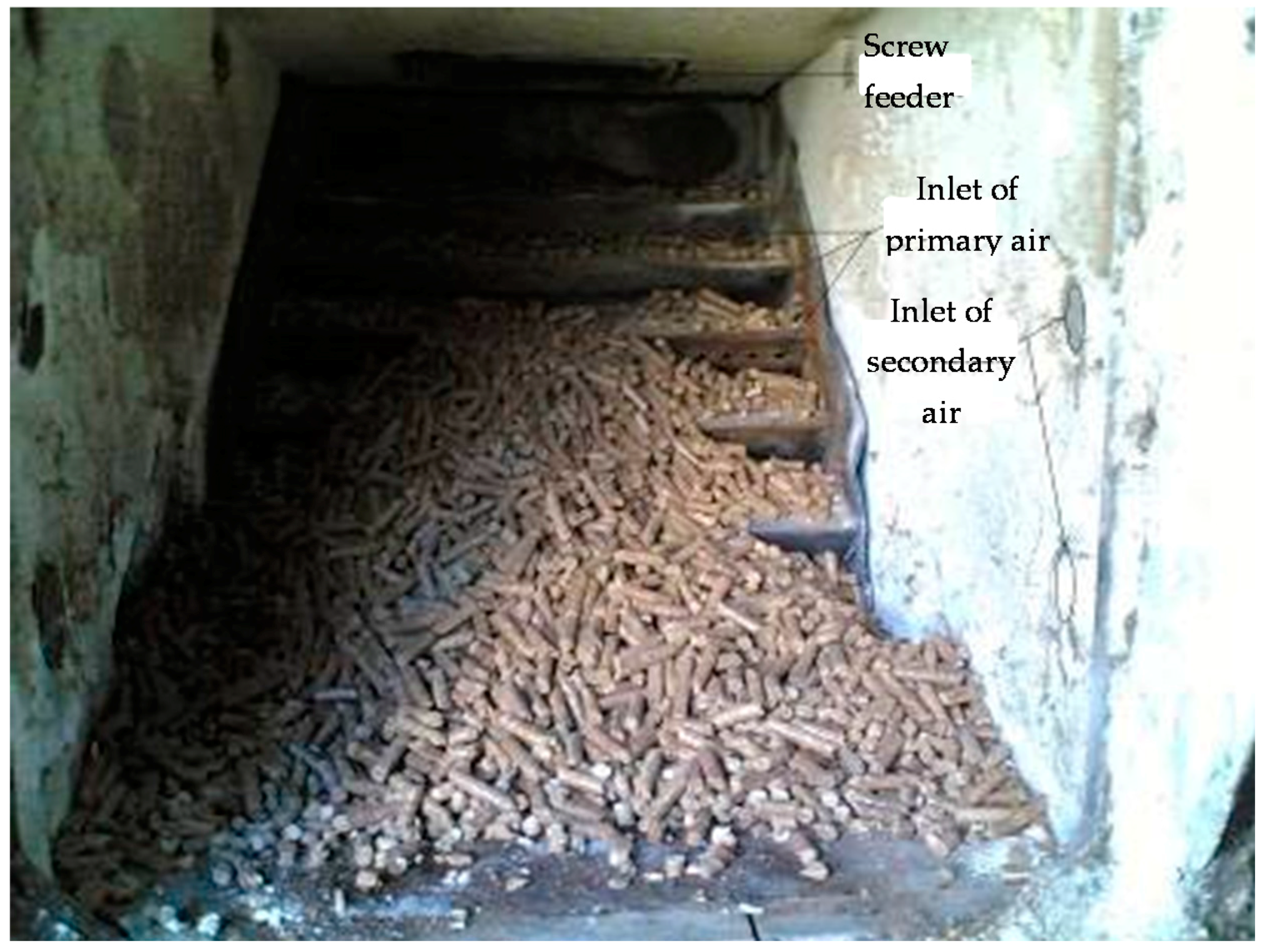
| Parameter | Type of Pellet | |
|---|---|---|
| Almond Tree | Olive Tree | |
| Diameter (mm) | 6 | 6 |
| Length (mm) | 10–31 | 10–24 |
| Bulk density (kg·m−3) | 620 | 650 |
| Parameter | Type of Pellet | |||||
|---|---|---|---|---|---|---|
| Almond Tree | Olive Tree | |||||
| Stabilized sample | Dry sample | Received sample | Stabilized sample | Dry sample | Received sample | |
| Immediate Analysis (% weight) | ||||||
| Moisture | 4.53 ± 0.04 | 0.00 ± 0.00 | 3.18 ± 0.03 | 4.40 ± 0.05 | 0.00 ± 0.00 | 2.93 ± 0.03 |
| Ash | 2.62 ± 0.36 | 2.74 ± 0.37 | 2.66 ± 0.36 | 2.54 ± 0.39 | 2.66 ± 0.41 | 2.58 ± 0.40 |
| Volatile matter | 75.73 ± 1.85 | 79.32 ± 1.93 | 76.80 ± 1.87 | 77.26 ± 1.98 | 80.82 ± 2.07 | 78.45 ± 2.01 |
| Fixed carbon | 17.12 ± 0.42 | 17.94 ± 0.44 | 17.36 ± 0.42 | 15.80 ± 0.40 | 16.52 ± 0.42 | 16.04 ± 0.41 |
| Elemental Analysis (% weight) | ||||||
| Carbon | 45.27 ± 1.11 | 47.42 ± 1.16 | 45.91 ± 1.12 | 45.20 ± 1.16 | 47.28 ± 1.21 | 45.90 ± 1.18 |
| Hydrogen 1 | 5.66 ± 0.05 | 5.40 ± 0.05 | 5.58 ± 0.05 | 5.80 ± 0.07 | 5.55 ± 0.06 | 5.72 ± 0.07 |
| Nitrogen | 0.49 ± 0.07 | 0.51 ± 0.07 | 0.50 ± 0.07 | 0.48 ± 0.07 | 0.50 ± 0.08 | 0.49 ± 0.08 |
| Sulfur | 0.00 ± 0.00 | 0.00 ± 0.00 | 0.00 ± 0.00 | 0.00 ± 0.00 | 0.00 ± 0.00 | 0.00 ± 0.00 |
| Heating Value (kcal·kg−1) | ||||||
| Upper heating value | 4369 | 4576 | 4431 | 4373 | 4574 | 4440 |
| Lower heating value | 4048 | 4295 | 4122 | 4046 | 4285 | 4126 |
| Other Properties | ||||||
| Energy density (MJ·m−3) | 11,146 | 11,658 | ||||
| Air-fuel ratiostoichiometric | 4.751 | 4.711 | ||||
| Adiabatic temperature of the flame (°C) | 2308 | 2293 | ||||
| Type of Pellet | Nominal Power (kW) | Emissions | |||
|---|---|---|---|---|---|
| CO (ppm at 6% O2) | CO (ppm at 13% O2) | NOx (ppm at 6% O2) | NOx (ppm at 13% O2) | ||
| Almond tree | 150 | 225.3 | 119.5 | 365.8 | 259.4 |
| Olive tree | 165 | 351.6 | 186.4 | 333.2 | 236.3 |
| Parameter | Fuel | |||||||||||
|---|---|---|---|---|---|---|---|---|---|---|---|---|
| Pellet from Olive Tree | Pellet from Almond Tree | |||||||||||
| Operation Parameters | ||||||||||||
| Operation time (s) | 2 | 3 | 4 | 5 | 6 | 7 | 2 | 3 | 4 | 5 | 6 | 7 |
| Shutdown time (s) | 20 | 20 | 20 | 20 | 20 | 20 | 20 | 20 | 20 | 20 | 20 | 20 |
| Delta temperature (°C) | 4.7 | 6.7 | 8.7 | 10.3 | 11.9 | 13.1 | 4.1 | 6.2 | 8.0 | 9.7 | 11.1 | 12.1 |
| Power (kW) | 64.5 | 91.8 | 120.2 | 141.4 | 164.2 | 180.5 | 56.3 | 85.2 | 110.3 | 134.1 | 152.6 | 166.1 |
| Partial load (%) | 39 | 56 | 73 | 86 | 99 | 109 | 34 | 52 | 67 | 81 | 92 | 100 |
| Gas Emission | ||||||||||||
| Oxygen concentration (%) | 16.7 | 14.5 | 12.1 | 10.4 | 8.4 | 6.7 | 17.2 | 15.5 | 13.3 | 11.5 | 9.5 | 8.0 |
| CO (ppm at 6% O2) | 5634.8 | 1558.8 | 977.1 | 429.5 | 351.6 | 3248.6 | 6275.0 | 2589.0 | 865.5 | 387.9 | 225.3 | 3542.6 |
| CO (ppm at 13% O2) | 2987.6 | 826.5 | 518.1 | 227.7 | 186.4 | 1722.4 | 3327.0 | 1372.7 | 458.9 | 205.7 | 119.5 | 1878.3 |
| NOx (ppm at 6% O2) | 382.3 | 397.2 | 363.4 | 369.8 | 333.2 | 251.0 | 457.4 | 463.1 | 388.4 | 378.0 | 365.8 | 356.9 |
| NOx (ppm at 13% O2) | 271.1 | 281.7 | 257.7 | 262.2 | 236.3 | 178.0 | 324.4 | 328.4 | 275.4 | 268.1 | 259.4 | 253.1 |
| Combustion Efficiency | ||||||||||||
| Gas temperature (°C) | 140.5 | 148.4 | 173.5 | 192.6 | 211.2 | 221.2 | 128.2 | 152.6 | 177.6 | 192.9 | 211.2 | 224.5 |
| Combustion efficiency (%) | 76.7 | 84.2 | 86.2 | 87.0 | 87.7 | 84.9 | 76.5 | 81.0 | 84.2 | 85.9 | 86.3 | 84.7 |
| Combustion efficiency 1 (%) | 79.9 | 87.2 | 90.4 | 92.0 | 93.1 | 89.8 | 78.0 | 85.0 | 89.4 | 91.4 | 92.1 | 90.2 |
| Air flow (m3·h−1) | 397.9 | 340.4 | 315.4 | 309.6 | 293.7 | 417.4 | 375.9 | 383.8 | 339.2 | 327.6 | 299.7 | 371.4 |
| Excess of air (%) | 386.7 | 223.3 | 135.1 | 97.9 | 62.0 | 100.9 | 441.6 | 283.2 | 171.6 | 120.2 | 78.9 | 101.5 |
| Fuel flow (kg·h−1) | 17.6 | 22.0 | 28.1 | 32.8 | 37.8 | 42.8 | 15.0 | 21.0 | 26.0 | 31.0 | 35.0 | 37.9 |
| Radiation and convection losses (%) | 2.6 | 1.8 | 1.4 | 1.2 | 1.0 | 1.0 | 2.9 | 1.9 | 1.5 | 1.2 | 1.1 | 1.0 |
© 2016 by the authors; licensee MDPI, Basel, Switzerland. This article is an open access article distributed under the terms and conditions of the Creative Commons Attribution (CC-BY) license (http://creativecommons.org/licenses/by/4.0/).
Share and Cite
Molina-Moreno, V.; Leyva-Díaz, J.C.; Sánchez-Molina, J. Pellet as a Technological Nutrient within the Circular Economy Model: Comparative Analysis of Combustion Efficiency and CO and NOx Emissions for Pellets from Olive and Almond Trees. Energies 2016, 9, 777. https://doi.org/10.3390/en9100777
Molina-Moreno V, Leyva-Díaz JC, Sánchez-Molina J. Pellet as a Technological Nutrient within the Circular Economy Model: Comparative Analysis of Combustion Efficiency and CO and NOx Emissions for Pellets from Olive and Almond Trees. Energies. 2016; 9(10):777. https://doi.org/10.3390/en9100777
Chicago/Turabian StyleMolina-Moreno, Valentín, Juan Carlos Leyva-Díaz, and Jorge Sánchez-Molina. 2016. "Pellet as a Technological Nutrient within the Circular Economy Model: Comparative Analysis of Combustion Efficiency and CO and NOx Emissions for Pellets from Olive and Almond Trees" Energies 9, no. 10: 777. https://doi.org/10.3390/en9100777
APA StyleMolina-Moreno, V., Leyva-Díaz, J. C., & Sánchez-Molina, J. (2016). Pellet as a Technological Nutrient within the Circular Economy Model: Comparative Analysis of Combustion Efficiency and CO and NOx Emissions for Pellets from Olive and Almond Trees. Energies, 9(10), 777. https://doi.org/10.3390/en9100777








